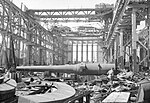Canon de 32 modèle 1870/93
| Canon de 32 modèle 1870/93 | |
|---|---|
 A 32 cm modèle 1870/93, on a Schneider railway mounting. | |
| Type | Railway gun |
| Place of origin | France |
| Service history | |
| In service | 1915-1945 |
| Used by | |
| Wars | World War I World War II |
| Production history | |
| Designer | Schneider |
| Designed | 1915 |
| Manufacturer | Schneider |
| Produced | 1915 |
| No. built | 6 |
| Specifications | |
| Mass | 162 t (159 long tons; 179 short tons) |
| Length | 26 m (85 ft) |
| Barrel length | 10.4 m (34 ft) L/32 |
| Shell | Separate loading bagged charges and projectiles |
| Shell weight | 388 kg (855 lb) |
| Caliber | 32 cm (13 in) |
| Breech | Interrupted screw breech |
| Recoil | Sliding recoil |
| Carriage | Two five-axle rail bogies |
| Elevation | 0 to +40° |
| Traverse | None |
| Rate of fire | 1 round every four minutes |
| Muzzle velocity | 675 m/s (2,210 ft/s) |
| Maximum firing range | 24.8 km (15 mi)[1] |
The Canon de 32 modèle 1870/93 was a French Railway gun used by the French Army during World War I and World War II. Guns captured after the Fall of France were given the German designation of 32 cm K(E) 652 (f) or 32 cm K(E) 652 (f) and used by them during World War II.
History
Although the majority of combatants had heavy field artillery prior to the outbreak of the First World War, none had adequate numbers of heavy guns in service, nor had they foreseen the growing importance of heavy artillery once the Western Front stagnated and trench warfare set in. Since aircraft of the period were not yet capable of carrying large diameter bombs the burden of delivering heavy firepower fell on the artillery. Two sources of heavy artillery suitable for conversion to field use were surplus coastal defense guns and naval guns.[1]
However, a paradox faced artillery designers of the time; while large caliber naval guns were common, large caliber land weapons were not due to their weight, complexity, and lack of mobility. Large caliber field guns often required extensive site preparation because the guns had to be broken down into multiple loads light enough to be towed by a horse team or the few traction engines of the time and then reassembled before use. Building a new gun could address the problem of disassembling, transporting and reassembling a large gun, but it did not necessarily address how to convert existing heavy weapons to make them more mobile. Rail transport proved to be the most practical solution because the problems of heavy weight, lack of mobility and reduced setup time were addressed.[1]
Design
The Canon de 32 modèle 1870/93 started life as six Canon de 32C modèle 1870/84 M coastal defense guns which were converted to railway guns.[2] The guns were typical built-up guns of the period with mixed construction consisting of a rifled steel liner and several layers of iron reinforcing hoops. In French service guns of mixed steel/iron construction were designated in centimeters while all steel guns were designated in millimeters. However, reference materials don't always distinguish the difference in construction and use either unit of measurement. The guns used an interrupted screw breech and fired separate loading bagged charges and projectiles. Since the barrels were coastal defense guns that were not intended for use at high angles of elevation the trunnions were relocated relatively far forward and the guns were nose heavy.[3]
The carriages consisted of a large rectangular steel base, which was suspended on two five-axle railroad bogies manufactured by Schneider.[3] The number of axles was determined by the weight limit for European railways of 17 tonnes per axle.[1] The guns could be elevated from 0 to +40° with typical firing range being between +22° to +40°. To load the gun the barrel was lowered and an elevated loading shell hoist could be erected.[3] The guns had no traversing mechanism and in order to aim the guns were drawn across a curved section of track. Once in position, a section of rail bed was reinforced with wooden beams then six steel beams under the center of the carriage were lowered onto the tracks and the carriage was jacked up to bear the weight of the gun. The guns used a sliding recoil or Glissement system and when fired the gun slid back a few meters and was then pushed back into position. The friction between the steel beams and the track limited the length of recoil. Due to their low cost and simplicity Schneider carriages were widely used on early railway guns. Although stable and effective this form of carriage was crude and latter guns incorporated improved recoil, elevation and traverse mechanisms.[4]
Photo Gallery
-
A diagram of the Schneider carriage system.
-
A Canon de 32 modèle 1870/93 being loaded.
-
A battery of French guns in action near Reims.
-
A RAF Bomber Command crew examines a barrel in a Krupp workshop in Essen Germany after World War II.
References
- ^ a b c d Hogg, Ian (2004). Allied artillery of World War One. Ramsbury: Crowood. pp. 129-134 & 218. ISBN 1861267126. OCLC 56655115.
- ^ "Canons de 32 C modèles 1870 - FortiffSéré". www.fortiffsere.fr. Retrieved 2018-09-04.
- ^ a b c Romanych, Mark; Heuer, Greg; Noon, Steve (2017). Railway Guns of World War I. New Vanguard. London: Osprey Publishing. pp. 5–15. ISBN 9781472816412. OCLC 999616340.
- ^ Miller, H. W., LTC, USA (1921). Railway Artillery, vols. I and II. Washington: Government Printing Office. pp. 68–72.
{{cite book}}: CS1 maint: multiple names: authors list (link)



